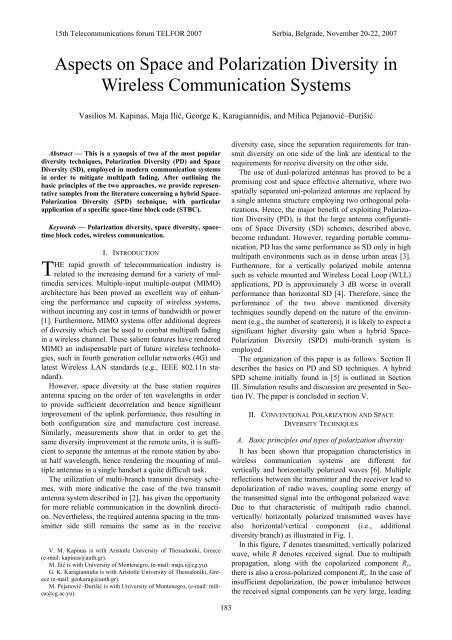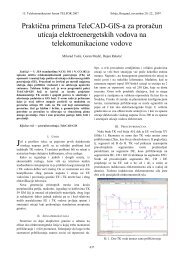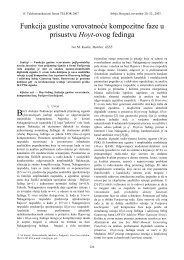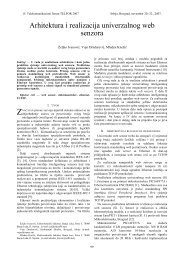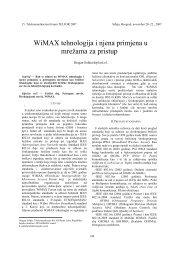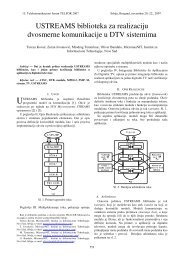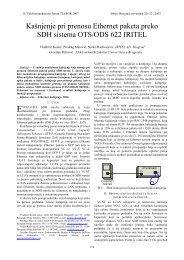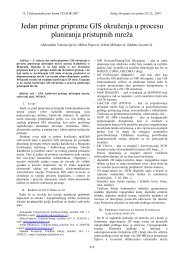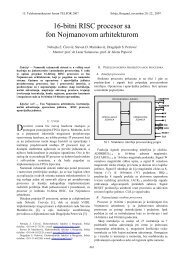Aspects on Space and Polarization Diversity in ... - Telfor 2007
Aspects on Space and Polarization Diversity in ... - Telfor 2007
Aspects on Space and Polarization Diversity in ... - Telfor 2007
You also want an ePaper? Increase the reach of your titles
YUMPU automatically turns print PDFs into web optimized ePapers that Google loves.
15th Telecommunicati<strong>on</strong>s forum TELFOR <strong>2007</strong> Serbia, Belgrade, November 20-22, <strong>2007</strong><br />
<str<strong>on</strong>g>Aspects</str<strong>on</strong>g> <strong>on</strong> <strong>Space</strong> <strong>and</strong> Polarizati<strong>on</strong> <strong>Diversity</strong> <strong>in</strong><br />
Wireless Communicati<strong>on</strong> Systems<br />
Vasilios M. Kap<strong>in</strong>as, Maja Ili, George K. Karagiannidis, <strong>and</strong> Milica Pejanovi–uriši<br />
<br />
Abstract — This is a synopsis of two of the most popular<br />
diversity techniques, Polarizati<strong>on</strong> <strong>Diversity</strong> (PD) <strong>and</strong> <strong>Space</strong><br />
<strong>Diversity</strong> (SD), employed <strong>in</strong> modern communicati<strong>on</strong> systems<br />
<strong>in</strong> order to mitigate multipath fad<strong>in</strong>g. After outl<strong>in</strong><strong>in</strong>g the<br />
basic pr<strong>in</strong>ciples of the two approaches, we provide representative<br />
samples from the literature c<strong>on</strong>cern<strong>in</strong>g a hybrid <strong>Space</strong>-<br />
Polarizati<strong>on</strong> <strong>Diversity</strong> (SPD) technique, with particular<br />
applicati<strong>on</strong> of a specific space-time block code (STBC).<br />
Keywords — Polarizati<strong>on</strong> diversity, space diversity, spacetime<br />
block codes, wireless communicati<strong>on</strong>.<br />
T<br />
I. INTRODUCTION<br />
HE rapid growth of telecommunicati<strong>on</strong> <strong>in</strong>dustry is<br />
related to the <strong>in</strong>creas<strong>in</strong>g dem<strong>and</strong> for a variety of multimedia<br />
services. Multiple-<strong>in</strong>put multiple-output (MIMO)<br />
architecture has been proved an excellent way of enhanc<strong>in</strong>g<br />
the performance <strong>and</strong> capacity of wireless systems,<br />
without <strong>in</strong>curr<strong>in</strong>g any cost <strong>in</strong> terms of b<strong>and</strong>width or power<br />
[1]. Furthermore, MIMO systems offer additi<strong>on</strong>al degrees<br />
of diversity which can be used to combat multipath fad<strong>in</strong>g<br />
<strong>in</strong> a wireless channel. These salient features have rendered<br />
MIMO an <strong>in</strong>dispensable part of future wireless technologies,<br />
such <strong>in</strong> fourth generati<strong>on</strong> cellular networks (4G) <strong>and</strong><br />
latest Wireless LAN st<strong>and</strong>ards (e.g., IEEE 802.11n st<strong>and</strong>ard).<br />
However, space diversity at the base stati<strong>on</strong> requires<br />
antenna spac<strong>in</strong>g <strong>on</strong> the order of ten wavelengths <strong>in</strong> order<br />
to provide sufficient decorrelati<strong>on</strong> <strong>and</strong> hence significant<br />
improvement of the upl<strong>in</strong>k performance, thus result<strong>in</strong>g <strong>in</strong><br />
both c<strong>on</strong>figurati<strong>on</strong> size <strong>and</strong> manufacture cost <strong>in</strong>crease.<br />
Similarly, measurements show that <strong>in</strong> order to get the<br />
same diversity improvement at the remote units, it is sufficient<br />
to separate the antennas at the remote stati<strong>on</strong> by about<br />
half wavelength, hence render<strong>in</strong>g the mount<strong>in</strong>g of multiple<br />
antennas <strong>in</strong> a s<strong>in</strong>gle h<strong>and</strong>set a quite difficult task.<br />
The utilizati<strong>on</strong> of multi-branch transmit diversity schemes,<br />
with more <strong>in</strong>dicative the case of the two transmit<br />
antenna system described <strong>in</strong> [2], has given the opportunity<br />
for more reliable communicati<strong>on</strong> <strong>in</strong> the downl<strong>in</strong>k directi<strong>on</strong>.<br />
Nevertheless, the required antenna spac<strong>in</strong>g <strong>in</strong> the transmitter<br />
side still rema<strong>in</strong>s the same as <strong>in</strong> the receive<br />
V. M. Kap<strong>in</strong>as is with Aristotle University of Thessal<strong>on</strong>iki, Greece<br />
(e-mail: kap<strong>in</strong>as@auth.gr).<br />
M. Ili is with University of M<strong>on</strong>tenegro, (e-mail: maja.i@cg.yu).<br />
G. K. Karagiannidis is with Aristotle University of Thessal<strong>on</strong>iki, Greece<br />
(e-mail: geokarag@auth.gr).<br />
M. Pejanovi–uriši is with University of M<strong>on</strong>tenegro, (e-mail: milica@cg.ac.yu).<br />
diversity case, s<strong>in</strong>ce the separati<strong>on</strong> requirements for transmit<br />
diversity <strong>on</strong> <strong>on</strong>e side of the l<strong>in</strong>k are identical to the<br />
requirements for receive diversity <strong>on</strong> the other side.<br />
The use of dual-polarized antennas has proved to be a<br />
promis<strong>in</strong>g cost <strong>and</strong> space effective alternative, where two<br />
spatially separated uni-polarized antennas are replaced by<br />
a s<strong>in</strong>gle antenna structure employ<strong>in</strong>g two orthog<strong>on</strong>al polarizati<strong>on</strong>s.<br />
Hence, the major benefit of exploit<strong>in</strong>g Polarizati<strong>on</strong><br />
<strong>Diversity</strong> (PD), is that the large antenna c<strong>on</strong>figurati<strong>on</strong>s<br />
of <strong>Space</strong> <strong>Diversity</strong> (SD) schemes, described above,<br />
become redundant. However, regard<strong>in</strong>g portable communicati<strong>on</strong>,<br />
PD has the same performance as SD <strong>on</strong>ly <strong>in</strong> high<br />
multipath envir<strong>on</strong>ments such as <strong>in</strong> dense urban areas [3].<br />
Furthermore, for a vertically polarized mobile antenna<br />
such as vehicle mounted <strong>and</strong> Wireless Local Loop (WLL)<br />
applicati<strong>on</strong>s, PD is approximately 3 dB worse <strong>in</strong> overall<br />
performance than horiz<strong>on</strong>tal SD [4]. Therefore, s<strong>in</strong>ce the<br />
performance of the two above menti<strong>on</strong>ed diversity<br />
techniques soundly depend <strong>on</strong> the nature of the envir<strong>on</strong>ment<br />
(e.g., the number of scatterers), it is likely to expect a<br />
significant higher diversity ga<strong>in</strong> when a hybrid <strong>Space</strong>-<br />
Polarizati<strong>on</strong> <strong>Diversity</strong> (SPD) multi-branch system is<br />
employed.<br />
The organizati<strong>on</strong> of this paper is as follows. Secti<strong>on</strong> II<br />
describes the basics <strong>on</strong> PD <strong>and</strong> SD techniques. A hybrid<br />
SPD scheme <strong>in</strong>itially found <strong>in</strong> [5] is outl<strong>in</strong>ed <strong>in</strong> Secti<strong>on</strong><br />
III. Simulati<strong>on</strong> results <strong>and</strong> discussi<strong>on</strong> are presented <strong>in</strong> Secti<strong>on</strong><br />
IV. The paper is c<strong>on</strong>cluded <strong>in</strong> secti<strong>on</strong> V.<br />
II. CONVENTIONAL POLARIZATION AND SPACE<br />
DIVERSITY TECHNIQUES<br />
A. Basic pr<strong>in</strong>ciples <strong>and</strong> types of polarizati<strong>on</strong> diversity<br />
It has been shown that propagati<strong>on</strong> characteristics <strong>in</strong><br />
wireless communicati<strong>on</strong> systems are different for<br />
vertically <strong>and</strong> horiz<strong>on</strong>tally polarized waves [6]. Multiple<br />
reflecti<strong>on</strong>s between the transmitter <strong>and</strong> the receiver lead to<br />
depolarizati<strong>on</strong> of radio waves, coupl<strong>in</strong>g some energy of<br />
the transmitted signal <strong>in</strong>to the orthog<strong>on</strong>al polarized wave.<br />
Due to that characteristic of multipath radio channel,<br />
vertically/ horiz<strong>on</strong>tally polarized transmitted waves have<br />
also horiz<strong>on</strong>tal/vertical comp<strong>on</strong>ent (i.e., additi<strong>on</strong>al<br />
diversity branch) as illustrated <strong>in</strong> Fig. 1.<br />
In this figure, T denotes transmitted, vertically polarized<br />
wave, while R denotes received signal. Due to multipath<br />
propagati<strong>on</strong>, al<strong>on</strong>g with the copolarized comp<strong>on</strong>ent R y ,<br />
there is also a cross-polarized comp<strong>on</strong>ent R x . In the case of<br />
<strong>in</strong>sufficient depolarizati<strong>on</strong>, the power imbalance between<br />
the received signal comp<strong>on</strong>ents can be very large, lead<strong>in</strong>g<br />
183
thus to low diversity ga<strong>in</strong>. The parameter that <strong>in</strong>dicates the<br />
power difference between the average power of the copolarized<br />
<strong>and</strong> cross-polarized signals, is denoted as crosspolar<br />
discrim<strong>in</strong>ati<strong>on</strong> (XPD). High XPD values can lead to<br />
significant degradati<strong>on</strong> of the system performance.<br />
Typical values of this parameter vary from 1-10 dB <strong>in</strong><br />
urban/suburban envir<strong>on</strong>ment, <strong>and</strong> 10-18 dB <strong>in</strong> rural envir<strong>on</strong>ment<br />
[7].<br />
B. <strong>Space</strong> diversity system<br />
Communicati<strong>on</strong> reliability <strong>in</strong> a time-vary<strong>in</strong>g transmissi<strong>on</strong><br />
envir<strong>on</strong>ment can be improved by receiv<strong>in</strong>g the<br />
signal <strong>on</strong> two or more <strong>in</strong>dependent branches <strong>and</strong> particular<br />
comb<strong>in</strong><strong>in</strong>g of the output <strong>in</strong> some optimum manner. In the<br />
case of SD, the <strong>in</strong>dependent paths are artificially created<br />
by appropriate utilizati<strong>on</strong> of multiple antennas either at the<br />
transmitter or/<strong>and</strong> at the receiver side, lead<strong>in</strong>g thus to<br />
transmit diversity (Fig. 4a) or/<strong>and</strong> receive diversity (Fig.<br />
4b) system designs.<br />
Fig. 1. The effect of depolarizati<strong>on</strong> due to multiple reflecti<strong>on</strong>s.<br />
Another very important parameter describ<strong>in</strong>g a polarizati<strong>on</strong><br />
diversity system is the correlati<strong>on</strong> coefficient between<br />
the received signal envelopes. S<strong>in</strong>ce polarizati<strong>on</strong> diversity<br />
assumes utilizati<strong>on</strong> of <strong>on</strong>ly <strong>on</strong>e dual-polarized antenna, the<br />
resulted c<strong>on</strong>figurati<strong>on</strong> necessarily leads to certa<strong>in</strong> signal<br />
correlati<strong>on</strong>. However, studies have shown that multiple<br />
antenna systems can achieve a significant diversity ga<strong>in</strong> as<br />
l<strong>on</strong>g as the correlati<strong>on</strong> coefficient is less than 0.7 [8].<br />
When polarizati<strong>on</strong> diversity is c<strong>on</strong>sidered, this<br />
requirement is almost always fulfilled. In fact,<br />
experimental results have shown that envelope correlati<strong>on</strong><br />
coefficient is generally even less than 0.2 [7]. Therefore,<br />
polarizati<strong>on</strong> diversity presents a space <strong>and</strong> cost effective<br />
soluti<strong>on</strong>, appear<strong>in</strong>g attractive for both network operators<br />
who suffer lack of space for mount<strong>in</strong>g antennas, <strong>and</strong><br />
mobile manufacturers who provide mobile term<strong>in</strong>als with<br />
limited size.<br />
A typical c<strong>on</strong>figurati<strong>on</strong> of polarizati<strong>on</strong> diversity system<br />
c<strong>on</strong>sists of <strong>on</strong>e transmit <strong>and</strong> <strong>on</strong>e dual-polarized receive<br />
antenna (i.e., maximal diversity order of two), as illustrated<br />
<strong>in</strong> Fig. 2.<br />
Fig. 2. Receive polarizati<strong>on</strong> diversity system.<br />
In order to additi<strong>on</strong>ally <strong>in</strong>crease diversity order, c<strong>on</strong>figurati<strong>on</strong>s<br />
with dual-polarized transmit <strong>and</strong> receive antennas<br />
are also implemented (Fig. 3).<br />
Fig. 3. Illustrati<strong>on</strong> of polarizati<strong>on</strong> diversity system with<br />
dual-polarized transmit <strong>and</strong> receive antenna.<br />
Fig. 4a. Transmit diversity system.<br />
Fig. 4b. Receive diversity system.<br />
Both SD techniques exploit the lack of correlati<strong>on</strong> between<br />
fades <strong>on</strong> each branch of the diversity system. The<br />
effect of spatial diversity <strong>on</strong> the system performance can<br />
be easily expla<strong>in</strong>ed if we c<strong>on</strong>sider the typical graph of Fig.<br />
5, show<strong>in</strong>g the way <strong>in</strong> which the signal received <strong>on</strong> two<br />
base stati<strong>on</strong> antennas suffers <strong>in</strong>dependent fad<strong>in</strong>g from the<br />
two uncorrelated paths (assum<strong>in</strong>g antennas at least ten<br />
wavelengths apart). At several po<strong>in</strong>ts, the two received<br />
signals r 1 <strong>and</strong> r 2 fall momentarily below some threshold at<br />
which an acceptable SNR value is obta<strong>in</strong>ed. The moments<br />
at which fades occur <strong>on</strong> the first antenna are <strong>in</strong> general<br />
different from the fades occurr<strong>in</strong>g <strong>on</strong> the antenna of the<br />
sec<strong>on</strong>d branch. Therefore, the overall system performance<br />
depends <strong>on</strong> the lack of correlati<strong>on</strong> between fades <strong>on</strong> each<br />
branch <strong>and</strong> hence particular comb<strong>in</strong><strong>in</strong>g of the two replicas<br />
can lead to <strong>in</strong>creased diversity ga<strong>in</strong>. Such diversity comb<strong>in</strong><strong>in</strong>g<br />
techniques, <strong>in</strong>clud<strong>in</strong>g the optimal Maximal-Ratio<br />
Comb<strong>in</strong><strong>in</strong>g (MRC), Equal Ga<strong>in</strong> Comb<strong>in</strong><strong>in</strong>g (EGC), Selecti<strong>on</strong><br />
Comb<strong>in</strong><strong>in</strong>g (SC) <strong>and</strong> Switched Comb<strong>in</strong><strong>in</strong>g, are well<br />
described <strong>in</strong> [9–12].<br />
From the above menti<strong>on</strong>ed techniques, MRC is the most<br />
effective <strong>on</strong>e <strong>in</strong> a multipath envir<strong>on</strong>ment, as it makes optimal<br />
use of the total signal power received <strong>in</strong> all branches<br />
at any <strong>in</strong>stant. This fact justifies why SD provides higher<br />
diversity ga<strong>in</strong> <strong>in</strong> urban areas than it does <strong>in</strong> other envir<strong>on</strong>ments;<br />
s<strong>in</strong>ce there are more scatterers <strong>in</strong> urban envir<strong>on</strong>ments,<br />
a maximal ratio comb<strong>in</strong>er will make use of all<br />
the received signal energy added coherently [13].<br />
In the case of transmit diversity, the Symbol Error Rate<br />
(SER) performance is expected to be similar to that of the<br />
184
previous case (receive diversity), with a 3 dB disadvantage<br />
for each branch due to the extra power needed for simultaneous<br />
symbol transmissi<strong>on</strong> from all transmit antennas.<br />
for the fad<strong>in</strong>g coefficients [14]<br />
* *<br />
vv vh Ehhvhhh<br />
E h h<br />
2 2<br />
Ehvv<br />
<br />
Ehhh<br />
1<br />
t <br />
a a<br />
, ,(2)<br />
2 2 * *<br />
Ehvh<br />
<br />
Ehhv<br />
<br />
a Ehvv hhv Ehvhhhh<br />
r<br />
<br />
<br />
a a<br />
where t, r are the transmit <strong>and</strong> receive correlati<strong>on</strong> coefficients<br />
respectively <strong>and</strong> a [0,1] is a parameter depend<strong>in</strong>g<br />
<strong>on</strong> the XPD accord<strong>in</strong>g to the relati<strong>on</strong><br />
<br />
<br />
<br />
<br />
<br />
<br />
2 2<br />
vv<br />
hh<br />
E h E h<br />
1<br />
XPD .<br />
E h E h a<br />
(3)<br />
2 2<br />
hv<br />
vh<br />
<br />
<br />
Fig. 5. Received signals from two different paths.<br />
III. THE SPACE-POLARIZATION DIVERSITY SCHEME<br />
We c<strong>on</strong>sider the communicati<strong>on</strong> l<strong>in</strong>k of Fig. 6 with <strong>on</strong>e<br />
dual-polarized antenna at both the transmitter <strong>and</strong> the receiver<br />
side with vertical (V pol ) <strong>and</strong> horiz<strong>on</strong>tal (H pol ) polarizati<strong>on</strong><br />
states. We assume that the encod<strong>in</strong>g procedure at the<br />
transmitter employs the STBC of [2].<br />
Fig. 6. Dual-polarizati<strong>on</strong> transmit-receive system<br />
employ<strong>in</strong>g STBC encod<strong>in</strong>g.<br />
Specifically, each block <strong>in</strong>volves the transmissi<strong>on</strong> of<br />
two complex symbols s v , s h dur<strong>in</strong>g <strong>on</strong>e symbol period,<br />
whereas dur<strong>in</strong>g the follow<strong>in</strong>g symbol period, symbols –<br />
s h * , s v * are launched with vertical <strong>and</strong> horiz<strong>on</strong>tal polarizati<strong>on</strong>s<br />
respectively.<br />
The system model can be described by the matrix relati<strong>on</strong><br />
rXH+n, where r is the received matrix with entries<br />
all the signals arrived at the receiver at time <strong>in</strong>stants 1 (end<br />
of 1st time slot) or 2 (end of 2nd time slot) <strong>on</strong> the two possible<br />
polarizati<strong>on</strong> states, X is the Alamouti STBC [2], H<br />
presents the channel or polarizati<strong>on</strong> matrix <strong>in</strong>volv<strong>in</strong>g<br />
complex Gaussian r<strong>and</strong>om variables of zero mean,<br />
whereas n st<strong>and</strong>s for the complex additive white Gaussian<br />
noise (AWGN) matrix. In element wise form, the model is<br />
described by<br />
r1v r1h sv<br />
shhvv hvh n1v n1h<br />
<br />
<br />
,<br />
r<br />
* *<br />
2v r <br />
2h s h<br />
h s <br />
<br />
v hv hhh n2v n2h<br />
<br />
where h vh , h hv represent the cross coupl<strong>in</strong>gs between the<br />
two polarizati<strong>on</strong> states. To proceed further, we assume a<br />
quasi-static flat fad<strong>in</strong>g channel with some extra limitati<strong>on</strong>s<br />
(1)<br />
From equati<strong>on</strong> (3), it is obvious that values of a close<br />
to unity corresp<strong>on</strong>d to small values of XPD <strong>and</strong> therefore<br />
high polarizati<strong>on</strong> diversity. It is <strong>in</strong>terest<strong>in</strong>g that the case of<br />
a1 (XPD(dB)0) corresp<strong>on</strong>ds to a “true” 2x2 MIMO<br />
system with uncorrelated fad<strong>in</strong>g parameters, able to provide<br />
maximum diversity order equal to 4. For a0, the<br />
system can be c<strong>on</strong>sidered as two <strong>in</strong>dependent s<strong>in</strong>gle-<strong>in</strong>put<br />
s<strong>in</strong>gle-output (SISO) systems at the orig<strong>in</strong> of the loss <strong>in</strong><br />
spatial diversity [15].<br />
IV. SIMULATION RESULTS AND DISCUSSION<br />
Simulati<strong>on</strong> results of separated works [5], [14–17],<br />
verify the follow<strong>in</strong>g statements:<br />
The SPD scheme employ<strong>in</strong>g the Alamouti code outperforms<br />
the uncoded PD scheme <strong>in</strong> terms of the Bit Error<br />
Rate (BER).<br />
The performance of the well-known SD scheme of Alamouti<br />
degrades with the use of dual-polarized antennas.<br />
This can be expla<strong>in</strong>ed if we c<strong>on</strong>sider that the new degree<br />
of freedom <strong>in</strong>troduced by the polarizati<strong>on</strong> diversity can<br />
easily spoil the orthog<strong>on</strong>al structure of the code.<br />
Values of a close to unity provide the best BER with<br />
similar performance to that of the SD case for uncorrelated<br />
branches (tr0). Actually, this ideal case is far from a<br />
realistic channel.<br />
Transmit <strong>and</strong> receive correlati<strong>on</strong> have an identical<br />
impact <strong>on</strong> the system performance.<br />
Increase <strong>in</strong> either the correlati<strong>on</strong> coefficients or the<br />
XPD dramatically degrades the performance of the SPD<br />
communicati<strong>on</strong> system (Fig. 7).<br />
A comm<strong>on</strong> c<strong>on</strong>siderati<strong>on</strong> of a realistic channel (a0.4,<br />
t0.5, r0.3) gives BER performance loss approximately<br />
equal to 2.5 dB (Fig. 8) with respect to the ideal case<br />
(a1, tr0).<br />
V. CONCLUSION<br />
In this paper, the performance of a system with <strong>on</strong>e<br />
dual-polarized antenna, at both the transmitter <strong>and</strong> the<br />
receiver side with simultaneous employment of the<br />
Alamouti STBC, was compared to the traditi<strong>on</strong>al space<br />
185
<strong>and</strong> polarizati<strong>on</strong> diversity counterparts. The results revealed<br />
that the SPD technique outperforms the PD, but its<br />
performance deteriorates as the correlati<strong>on</strong> coefficients<br />
<strong>and</strong> the XPD parameter <strong>in</strong>crease. However, the replacement<br />
of the two separated antennas <strong>in</strong> either the transmitter<br />
or/<strong>and</strong> the receiver side of the classical 2x2 Alamouti<br />
scheme by a dual-polarized antenna, leads to worse BER<br />
curves. The authors estimate that future challenges <strong>in</strong><br />
wireless communicati<strong>on</strong>, am<strong>on</strong>g others, will <strong>in</strong>volve:<br />
Study of 2M x 2N MIMO systems employ<strong>in</strong>g SPD antenna<br />
c<strong>on</strong>figurati<strong>on</strong>s at both the transmitter <strong>and</strong> the receiver<br />
side (with M dual-polarized T x <strong>and</strong> N dual-polarized<br />
R x antennas), us<strong>in</strong>g square orthog<strong>on</strong>al or quasi-orthog<strong>on</strong>al<br />
STBC of order M.<br />
Design of rec<strong>on</strong>figurable antenna arrays able to adapt<br />
their polarizati<strong>on</strong> (to more than two states) <strong>and</strong> geometry<br />
(by activat<strong>in</strong>g various dipoles) accord<strong>in</strong>g to the special<br />
nature of each envir<strong>on</strong>ment.<br />
Fig. 7. Influence of XPD <strong>on</strong> BER performance for<br />
uncorrelated branches [Grau et al, 16].<br />
ACKNOWLEDGMENT<br />
This work was performed with<strong>in</strong> the framework of Bilateral<br />
S&T Cooperati<strong>on</strong> between the Hellenic Republic <strong>and</strong><br />
the Republic of M<strong>on</strong>tenegro, funded by the General Secretariat<br />
for Research <strong>and</strong> Technology (GSRT) of the Hellenic<br />
M<strong>in</strong>istry of Development <strong>and</strong> M<strong>on</strong>tenegr<strong>in</strong> M<strong>in</strong>istry of<br />
Educati<strong>on</strong> <strong>and</strong> Science.<br />
REFERENCES<br />
[1] G. J. Fosch<strong>in</strong>i <strong>and</strong> M. J. Gans, “On limits of wireless communicati<strong>on</strong><br />
<strong>in</strong> a fad<strong>in</strong>g envir<strong>on</strong>ment when us<strong>in</strong>g multiple antennas,” Wirel.<br />
Pers. Commun., vol. 6, pp. 311–335, March 1998.<br />
[2] S. M. Alamouti, “A simple transmit diversity technique for wireless<br />
communicati<strong>on</strong>s,” IEEE J. Sel. Areas Commun., vol. 16, pp. 1451-<br />
1458, Oct. 1998.<br />
[3] A. S<strong>in</strong>ger, “<strong>Space</strong> vs. Polarizati<strong>on</strong> <strong>Diversity</strong>,” Wireless Review, pp.<br />
164-168, Feb. 1998.<br />
[4] R. Ganesh <strong>and</strong> K. Pahlavan, Wireless Network Deployments, Kluwer<br />
Academic Publishers, 2000.<br />
[5] Z. Zhao, S. Staplet<strong>on</strong>, <strong>and</strong> J. Cavers, “Analysis of polarizati<strong>on</strong><br />
diversity scheme with channel cod<strong>in</strong>g,” <strong>in</strong> Proc. IEEE Vehic. Technol.<br />
C<strong>on</strong>f., Amsterdam, Sept. 1999.<br />
[6] W.C.–Y. Lee <strong>and</strong> Yu S.Yeh, “Polarizati<strong>on</strong> diversity system for<br />
mobile radio,” IEEE Trans. Commun., vol. com-20, Oct. 1972.<br />
[7] J. Jootar <strong>and</strong> J. R. Zeidler, “Performance analysis of polarizati<strong>on</strong><br />
receive diversity <strong>in</strong> correlated rayleigh fad<strong>in</strong>g channels,” <strong>in</strong> Proc.<br />
IEEE Globecom, pp. 774-778, Nov. 2003.<br />
[8] L. C. Lukama <strong>and</strong> D. J. Edvards, “Performance of spatial <strong>and</strong> polarizati<strong>on</strong><br />
diversity,” <strong>in</strong> Proc. Wireless Pers<strong>on</strong>al Multimedia Communicati<strong>on</strong>s<br />
(WPMC’01), Aalborg, Denmark, Sept. 2001.<br />
[9] D. Brennan, “L<strong>in</strong>ear diversity comb<strong>in</strong><strong>in</strong>g techniques,” <strong>in</strong> Proc. IRE,<br />
vol. 47, pp. 1075–1102, 1959.<br />
[10] W. C. Jakes, Microwave Mobile Communicati<strong>on</strong>, 2nd ed., Piscataway,<br />
NJ: Wiley-IEEE Press, 1994.<br />
[11] G. L. Stüber, Pr<strong>in</strong>ciples of Mobile Communicati<strong>on</strong>s, Norwell, MA:<br />
Kluwer Academic Publishers, 1996.<br />
[12] T. S. Rappaport, Wireless Communicati<strong>on</strong>s: Pr<strong>in</strong>ciples <strong>and</strong> Practice,<br />
Upper Saddle River, NJ: PTR Prentice-Hall, 1996.<br />
[13] B. S. Coll<strong>in</strong>s, “Polarizati<strong>on</strong> <strong>Diversity</strong> Antennas for Compact Base<br />
Stati<strong>on</strong>s”, Microwave J., vol. 43, pp. 76-88, Jan. 2000.<br />
[14] R. U. Nabar, H. Bölcskei, V. Erceg, D. Gesbert, <strong>and</strong> A. J. Paulraj,<br />
“Performance of multiantenna signal<strong>in</strong>g techniques <strong>in</strong> the presence<br />
of polarizati<strong>on</strong> diversity,” IEEE Trans. Signal Process., vol.50, pp.<br />
2553-2562, Oct. 2002.<br />
[15] B. Vrigneau, J. Letessier, P. Rosta<strong>in</strong>g, L. Coll<strong>in</strong>, <strong>and</strong> G. Burel,<br />
“Max-dm<strong>in</strong> precoder performances <strong>in</strong> a polarity diversity MIMO<br />
channel,” <strong>in</strong> Proc. 40th Annual Asilomar C<strong>on</strong>ference <strong>on</strong> Signals,<br />
Systems <strong>and</strong> Computers, California, 29 Oct.-1 Nov. 2006.<br />
[16] A. Grau, J. Romeu, S. Blanch, L. Jofre, H. Jafarkhani, <strong>and</strong> F. De<br />
Flaviis, “Performance enhancement of the Alamouti diversity<br />
scheme us<strong>in</strong>g polarizati<strong>on</strong>-rec<strong>on</strong>figurable antennas <strong>in</strong> different fad<strong>in</strong>g<br />
envir<strong>on</strong>ments,” <strong>in</strong> Proc. IEEE Internati<strong>on</strong>al Symposium <strong>on</strong> Antennas<br />
<strong>and</strong> Propagati<strong>on</strong> (IEEE AP-S), July 2006.<br />
[17] I. Frigyes <strong>and</strong> P. Horváth, “Polarizati<strong>on</strong>-time cod<strong>in</strong>g <strong>in</strong> satellite<br />
l<strong>in</strong>ks,” IEEE Satellite <strong>and</strong> <strong>Space</strong> Newsletter, vol. 15, pp. 6–8, 2005.<br />
Fig. 8. Comparis<strong>on</strong> between the ideal 2x2 MIMO <strong>and</strong> a<br />
realistic case [Vrigneau et al, 15] 1 .<br />
1 This figure refers also to the other two cases of systems with full<br />
channel state <strong>in</strong>formati<strong>on</strong> at the transmitter side (maximizati<strong>on</strong> of m<strong>in</strong>imum<br />
Euclidean distance <strong>and</strong> maximizati<strong>on</strong> of the received SNR), described<br />
<strong>in</strong> [15].<br />
186


